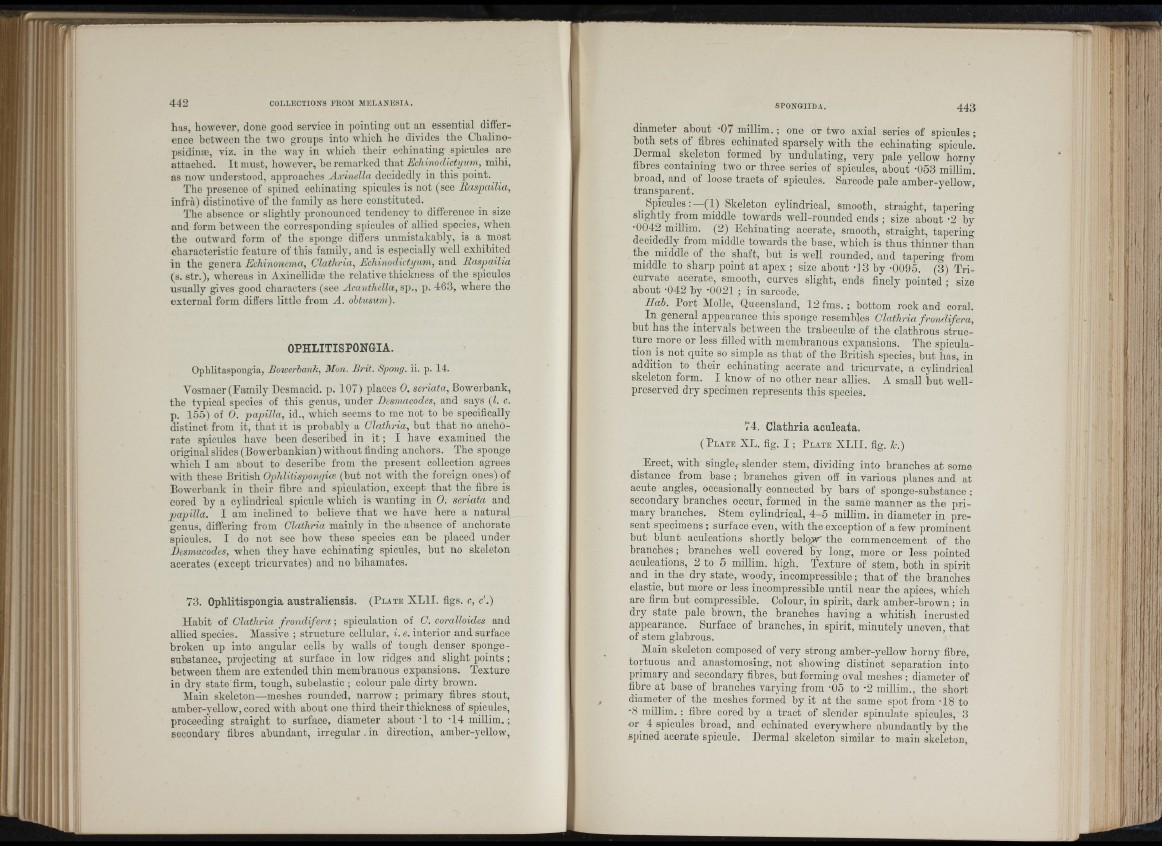
I 41 !
t
* i ,
i *
ll
has, however, done good service in pointing out an essential difference
between the two groups into which he divides the Chalino-
psidina?, viz. in tho way in which their echinating spicules are
attached. I t must, however, he remarked that Echinodictyum, mihi,
as now understood, approaches Axinella decidedly in this point.
The presence of spined echinating spicules is not (see liaspailia,
infnr) distinctive of the family as here constituted.
The absence or slightly pronounced tendency to difference in size
and form between the corresponding spicules of allied species, when
the outward form of the sponge differs unmistakably, is a most
characteristic feature of this family, and is especially well exhibited
in the genera Echinonema, Clathria, Echinodictyum, and liaspailia
(s. str.), whereas in Axinellidae tho relative thickness of the spicules
usually gives good characters (see Acanthella, a\>., p. 463, where the
external form differs little from A . obtusum).
OPHLITISPONGIA.
Oplditaspongia, Boiverhank, Alon. Brit. Spong. ii. p. 14.
Yosmaer (Family Desmacid. p. 107) places 0. seriata, Bowerbank,
the typical species of this genus, under Desmacodes, and says {I. c.
p. 155) of 0. papilla, id., which seems to me not to be specifically
distinct from it, th a t it is probably a Clathria, but th at no anchorate
spicules have been described in i t ; I have examined the
original slides (Bowerbankian) without finding anchors. The sponge
which I am about to describe from the present collection agrees
Avith these British Opihlitispongice (but not with the foreign ones) of
BoAverbank in their fibre and spiculation, except th at the fibre is
cored by a cylindrical spicule which is wanting in 0. seriata and
papilla. I am inclined to believe th a t we have here a natural
genus, differing from Clathria mainly in the absence of anchorate
spicules. I do not seo how these species can he placed under
Desmacodes, when they have echinating spicules, but no skeleton
acerates (except tricurvates) and no bihamates.
73. Ophlitispongia australiensis. ( P l a t e X L II. figs. c, c'.)
Habit of Clathria fro n d ifera; spiculation of C. coralloides and
allied species. Massive ; structure cellular, i. e. interior and surface
broken up into angular cells by walls of tough denser sponge-
substance, projecting at surface in low ridges and slight p o in ts;
between them are extended thin membranous expansions. Texture
in dry state firm, tough, subelastic; colour pale dirty brown.
Main skeleton—meshes rounded, narrow; primary fibres stout,
amber-yeUow, cored with about one third their thickness of spicules,
proceeding straight to surface, diameter about •! to ’14 millim.;
secondary fibres abundant, irreg u la r. in direction, amber-yellow.
443
diameter about '07 millim. ; one or two axial series of spicules;
both sets of fibres echinated sparsely with the echinating spicule!
Dermal skeleton formed by undulating, very pale yellow horny
fibres containing two or three series of spicules, about -053 millim.
broad, and of loose tracts of spicules. Sarcode pale amber-yellow
transparent. ’
Spicules: (1) Skeleton cylindrical, smooth, straight, tapering
slightly from middle towards Avell-rounded ends ; size about -2 by
•0042 millim. (2) Echinating acerate, smooth, straight, tapering
decidedly from middle towards the base, which is thus thinner than
the middle of the shaft, hut is well rounded, and tapering from
middle to sharp point at apex ; size about -13 by -0095. (3) Tricurvate
acerate, smooth, curAms slight, ends finely pointed ; size
about -042 by ’0021 ; in sarcode.
Hab. Port Molle, Queensland, 12 fms. ; bottom rock and coral.
In general appearance this sponge resembles Clathria frondifera,
but has the intervals between the trabeeulæ of the clathrous structure
more or less filled with membranous expansions. The spiculation
is not quite so simple as th at of the British species, hut has, in
addition to their echinating acerate and tricurvate, a cylindrical
skeleton form. I know of no other near allies. A small hut well-
preserved dry specimen represents this species.
r4. Clathria aculeata.
( P l a t e XL. fig. I ; P l a t e X L II. fig. h.)
^ Erect, with single,- slender stem, dividing into branches at some
distance from base ; branches given off in various planes and at
acute angles, occasionally connected by bars of sponge-substance ;
secondary branches occur, formed in the same manner as the primary
branches. Stem cylindrical, 4 -5 millim. in diameter in present
specimens ; surface even, with the exception of a few prominent
but blunt aculeations shortly below^ the commencement of tho
branches; branches well covered % long, more or less pointed
aculeations, 2 to 5 millim. high. Texture of stem, both in spirit
and jn the dry state, woody, incompressible ; that of the branches
elastic, hut more or less incompressible until near the apices, which
are firm but compressible. Colour, in spirit, dark amber-brown ; in
dry state pale brown, the branches having a whitish incrusted
appearance. Surface of branches, in spirit, minutely uneven, th at
of stem glabrous.
Main skeleton composed of very strong amber-yellow horny fibre,
tortuous and anastomosing, not showing distinct separation into
primary and secondary fibres, but forming oval meshes ; diameter of
fibre at base of branches varying from -05 to -2 millim., the short
diameter of the meshes formed by it at the same spot from -18 to
•8 millim. ; fibre cored by a tract of slender spinulate spicules, 3
or 4 spicules broad, and echinated everywhere abundantly by the
spined acerate spicule. Dermal skeleton similar to main skeleton,
in
Ml"
i*